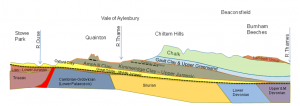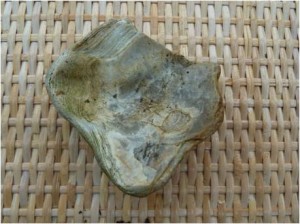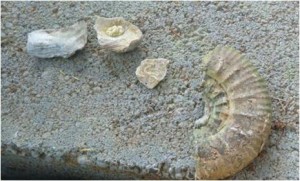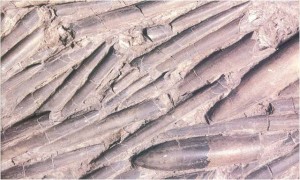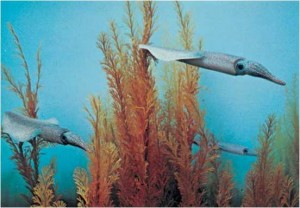Geology of Swanbourne
Our underlying Geology
By Clive Rodgers
The geological structure of North Bucks consists of Jurassic and Cretaceous sedimentary formations dipping gently to the East and unconformably over more steeply dipping older rocks.
The Oldest rocks in Swanbourne are the Oxford Clays exposed in Clack Brook, and the hill top is capped by shales known as the West Walton Formation which contains a very thin limestone at the top of Grange Hill. The latter is not exposed anywhere at the present time. These clays and shales are fossiliferous, containing fossil oysters known as Gryphaea, bullet shaped belemnites (ancestral cuttlefish) and ammonite fragments, all of which have been found in Clack Brook or have been dug up across the village.
However, buildings commonly contain or are made of slightly younger, Upper Jurassic Portland Limestone which caps Whitchurch Hill and this is almost certainly the original source. Most of these limestone pieces and boulders are highly fossiliferous, containing extinct bivalves such as Trigonia and gastropods (marine snails) known as Aptyxiella (nicknamed ‘Portland screws’).
Trouble identifying fossils from junk? Try the PDF Guide to the Identification of Swanbourne Artefacts by Clive Rodgers:-
A GUIDE TO IDENTIFYING SWANBOURNE ARTEFACTS – Copy
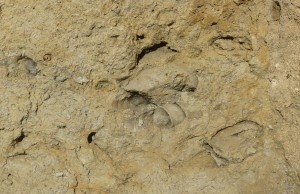
Portland Limestone in the stone doorway of Deverell’s Farm, Swanbourne, showing gastropods (Aptyxiella) sometimes knicknamed the ‘Portland Screw’ and bivalves.
Overall, the bedrock in Swanbourne approximates to around 160 million years old, and is only exposed at the surface today firstly because sea level has fallen and secondly the area was uplifted out of the sea during the Alpine Orogeny 20 million years ago. The overlying Cretaceous rocks were stripped off by erosion.
The next event was deposition of Glacial deposits within the last 1.8 million years during the Ice Age. Over the last 1.8 million years, there have been four major glacial advance. on one of these occasions, this entire area was smothered with thick ice. On the three other occasions, the ice never quite reached us, but melted 30 or 40 miles further North. Nevertheless, this area would have been Tundra, similar to Siberia today, and with Woolly Mammoths walking about.

Boulder Clay, full of stones transported by ice sits on Swanbourne Hill top after being dropped by glaciers over the last 1.8 million years.
There are two types of glacial deposit. Firstly there are the boulder clays, (up to a few metres thick) sitting over the Jurassic. The advancing ice sheets picked up boulders, stones and clay north of this area and dumped this load when the ice melted. Secondly, there are sand and gravel deposits derived from meltwater streams which are quite well sorted. These deposits sit within the boulder clay and are often responsible for springs in the village. Gravel deposits have been worked in many parts of Swanbourne Parish, usually for use in the building industry.
For further information on the geology of North Bucks or to join the Bucks Earth Heritage Group, please CLICK HERE:- http://www.bucksgeology.org.uk/


